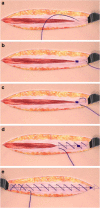A High-Strength, Absorbable, Antibacterial Knotless Tissue Control Device for Fascial Closure
- PMID: 28603661
- PMCID: PMC5442192
- DOI: 10.1007/s13669-017-0208-0
A High-Strength, Absorbable, Antibacterial Knotless Tissue Control Device for Fascial Closure
Abstract
Purpose of review: This review provides an overview of the STRATAFIX™ SYMMETRIC PDS™ Plus Knotless Tissue Control Device design and performance characteristics and highlights the device's relevance for use in gynecological procedures. Various device testing was conducted on tensile strength, fixation tab mass comparison to conventional suture knot tower, initiation stitch strength, and wound holding strength to highlight the STRATAFIX™ SYMMETRIC PDS™ Plus Device's key product attributes that may benefit general and minimally invasive gynecological procedures.
Recent findings: This article serves as a technological assessment of the latest barbed suture offered by Ethicon-STRATAFIX™ SYMMETRIC PDS™ Plus Knotless Tissue Control Device. This device is indicated for soft tissue approximation and can be used to close high tension areas, such as fascia.
Summary: Barbed sutures were successfully introduced to gynecologic surgery many years ago, and their safety and effectiveness have been demonstrated in a variety of gynecological surgical procedures. By eliminating the need to tie surgical knots, barbed suture provides a few key advantages over conventional suture, such as reducing operating room time, eliminating potential knot-related complications, and reducing suturing difficulty in open and minimally invasive gynecological procedures. Additionally, there are tensile strength and wound holding strength advantages (vs. conventional PDS™ Plus Suture) described in the product testing highlighted in this review that may be relevant for gynecological procedures.
Keywords: Barbed sutures; Knotless tissue control device; Stratafix™.
Conflict of interest statement
Conflict of Interest
Jesse G. Nawrocki, Heather Nonnenmann, Mark Mooney, Nadia Sutton, and Niels-Derrek Schmitz all declare to be salaried employees with stock options of Johnson & Johnson – Ethicon.
Due to the nature of this section and the anticipation of bias from the author as it pertains to his article topic, the article has been reviewed by Dr. Jon I. Einarsson of Brigham and Women’s Hospital and by Dr. Mark Levie of Montefiore Medical Center. Both reviewers do not have any conflict of interest with the product reviewed in the article, and they assert that the article is factual and free of excessive bias toward the subject.
Human and Animal Rights and Informed Consent
This article does not contain any studies with human or animal subjects performed by any of the authors.
Figures
Similar articles
-
Comparison of Barbed Sutures in Porcine Flexor Tenorrhaphy.Hand (N Y). 2016 Dec;11(4):475-478. doi: 10.1177/1558944715626928. Epub 2016 Feb 2. Hand (N Y). 2016. PMID: 28149217 Free PMC article.
-
In Vivo and In Vitro Anti-Bacterial Efficacy of Absorbable Barbed Polydioxanone Monofilament Tissue Control Device with Triclosan.Surg Infect (Larchmt). 2018 May/Jun;19(4):430-437. doi: 10.1089/sur.2017.275. Epub 2018 Apr 6. Surg Infect (Larchmt). 2018. PMID: 29624479
-
In vivo assessment of an absorbable and nonabsorbable knotless barbed suture for laparoscopic single-layer enterotomy closure: a clinical and biomechanical comparison against nonbarbed suture.J Laparoendosc Adv Surg Tech A. 2011 Dec;21(10):893-7. doi: 10.1089/lap.2011.0281. J Laparoendosc Adv Surg Tech A. 2011. PMID: 22129144
-
Barbed suture: a review of the technology and clinical uses in obstetrics and gynecology.Rev Obstet Gynecol. 2013;6(3-4):107-15. Rev Obstet Gynecol. 2013. PMID: 24920976 Free PMC article. Review.
-
Closing the Gap: Novel Abdominal Wound Closure Techniques.Surg Technol Int. 2018 Jun 1;32:25-31. Surg Technol Int. 2018. PMID: 29791700 Review.
Cited by
-
Evaluation of Wound Closure Outcomes Using Barbed Delayed Absorbable Polydioxanone Sutures After Emergency Laparotomy: An Observational Study.Cureus. 2025 Jan 10;17(1):e77257. doi: 10.7759/cureus.77257. eCollection 2025 Jan. Cureus. 2025. PMID: 39931621 Free PMC article.
-
Trends in adoption of knotless tissue control devices in robotic surgery.J Comp Eff Res. 2025 Apr;14(4):e240229. doi: 10.57264/cer-2024-0229. Epub 2025 Mar 17. J Comp Eff Res. 2025. PMID: 40095605 Free PMC article.
-
Effect of Suture Type and Suture Distance on Holding Strength in Nasal Septal Laceration Model.Turk Arch Otorhinolaryngol. 2021 Mar;59(1):1-7. doi: 10.4274/tao.2021.6100. Epub 2021 Mar 26. Turk Arch Otorhinolaryngol. 2021. PMID: 33912854 Free PMC article.
-
The Effect of Barbed Sutures on Complication Rates Post Colectomy: A Retrospective Case-Matched Review.Cureus. 2022 Sep 23;14(9):e29484. doi: 10.7759/cureus.29484. eCollection 2022 Sep. Cureus. 2022. PMID: 36312636 Free PMC article.
-
Clinical outcomes of triclosan-coated barbed suture in open hernia repair: a retrospective cohort study.Hernia. 2024 Aug;28(4):1239-1247. doi: 10.1007/s10029-024-03012-0. Epub 2024 Apr 12. Hernia. 2024. PMID: 38609582 Free PMC article.
References
-
- Naki MM, Api O, Acioglu HC, Ozkan S, Kars B, Unal O. Comparative study of a barbed suture, poliglecaprone-25 suture, and stapler in Pfannenstiel incisions performed for benign gynecological procedures: a randomized trial. Acta Obstet Gynecol Scand. 2010;89:1473–1477. doi: 10.3109/00016349.2010.516815. - DOI - PubMed
Publication types
LinkOut - more resources
Full Text Sources
Other Literature Sources
Research Materials
Miscellaneous


